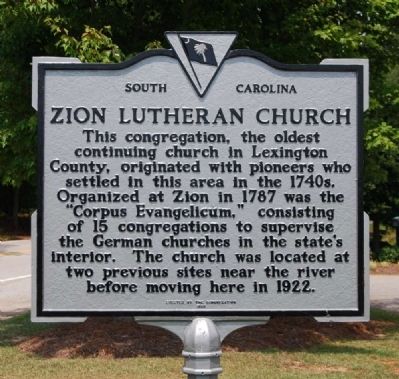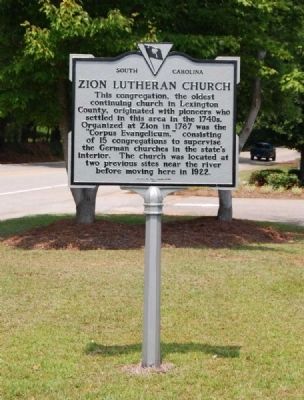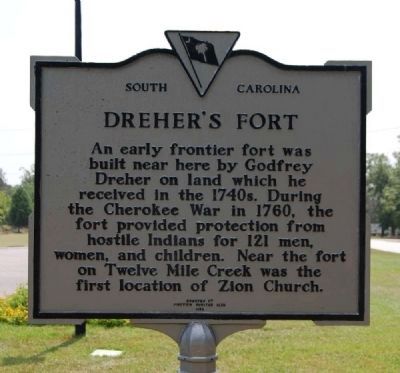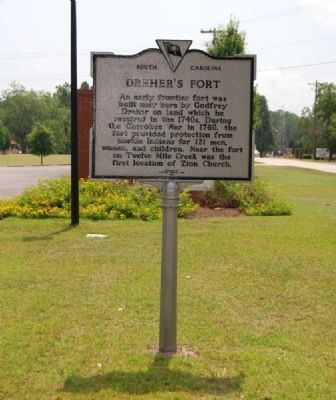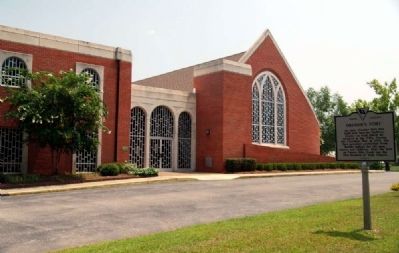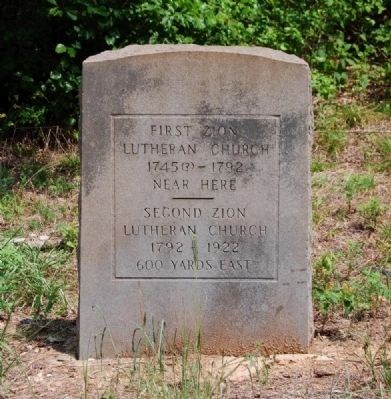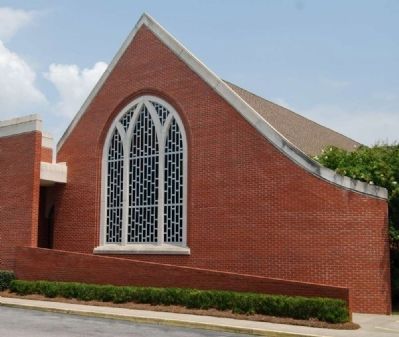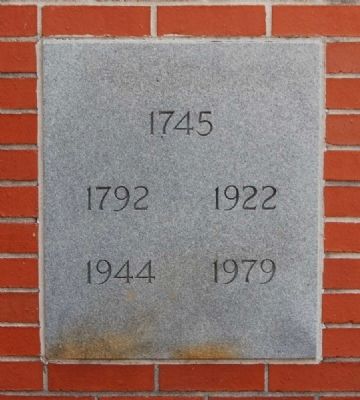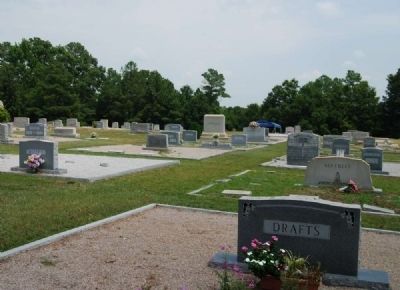Lexington in Lexington County, South Carolina — The American South (South Atlantic)
Zion Lutheran Church / Dreher's Fort
Erected 1986 by Congregation of Zion Lutheran Church (Zion Church Side); Pineview Ruritan Club (Dreher's Ford Side). (Marker Number 32-16.)
Topics. This historical marker is listed in these topic lists: Churches & Religion • Colonial Era • Military • Notable Events • Settlements & Settlers • Wars, US Indian. A significant historical year for this entry is 1787.
Location. 34° 1.259′ N, 81° 9.257′ W. Marker is in Lexington, South Carolina, in Lexington County. Marker is on Corley Mill Road, on the left when traveling south. Marker is located at the church. Touch for map. Marker is at or near this postal address: 226 Corley Mill Road, Lexington SC 29072, United States of America. Touch for directions.
Other nearby markers. At least 10 other markers are within 5 miles of this marker, measured as the crow flies. Delingo School (approx. 1.4 miles away); St. Andrew's Lutheran Church (approx. 2 miles away); Mt. Hebron United Methodist Church / Temperance Hall (approx. 2.3 miles away); The Sycamore Tree (approx. 3.3 miles away); Pine Grove Rosenwald School (approx. 3.3 miles away); Saluda Factory Cemetery (approx. 4 miles away); Saluda Factory Ruins (approx. 4.3 miles away); The Cherokee Path (approx. 4.4 miles away); Tarrar Springs (approx. 4.4 miles away); A Bridge to the Past (approx. 4.6 miles away). Touch for a list and map of all markers in Lexington.
Also see . . .
1. Thumbnail History of Zion Lutheran Church, Lexington, SC. Formed at least as early as 1745, in Lexington County, S. C. near the Saluda River in what was known as the Switzer's Neck area of the old Saxe Gotha Township near the pre-Revolutionary Godfrey Dreher Fort, Civil War Gen. William Tecumseh Sherman called it (in his journal) "the Dutch Church". (Submitted on August 12, 2009, by Brian Scott of Anderson, South Carolina.)
2. Anglo-Cherokee War. The Anglo-Cherokee War (1758–1761) (Cherokee:"war with those in the red coats" or "war with the english"), also known (from the Anglo-European perspective) as the Cherokee War, the Cherokee Uprising, the Cherokee Rebellion, was a conflict between British forces in North America and Cherokee Indians during the French and Indian War. (Submitted on August 12, 2009, by Brian Scott of Anderson, South Carolina.)
Additional commentary.
1. About the "Corpus Evangelicum"
We have now arrived at that period in the history of the Lutheran Church in the Carolinas, when the first attempt was made, in connection with the German Reformed ministers, to organize some kind of ecclesiastical body, that should have the supervision of all the German churches in the interior of the State of South Carolina.
This body was organized in Zion's Church, Lexington District (County), November 13th, 1787, and consisted of Lutheran and German Reformed ministers, together with lay deputies from the churches belonging to both denominations. It had the double name of Corpus Evangelicum and Unio Ecclesiastica, doubtless so given with the view that neither denomination could have occasion to object to the title and to its undenominational character. Its principal object was to make special arrangement for the proper incorporation of all the German churches by legislative enactment, which were located in the interior of the State; the Lutheran church in the city of Charleston having already secured its charter of incorporation. The ordination of a candidate to the office of the ministry indicated that the performance of this duty seemed to be also one of its objects; and the general oversight and welfare of all the churches in its connection, as was manifested by the presence of lav delegates, claimed a large share of the attention of that body.
The Lutheran congregation in Charleston never connected itself with that body; neither did the two Lutheran ministers, Revs. Faber and Martin, who resided there; but for what reason is not stated.
The Corpus Evangelicum was short-lived, as might have been expected, and as all such mixed ecclesiastical bodies must necessarily be. A union of denominations cannot be otherwise than false, where the united parties are not agreed either in doctrine or practice, for each party feels that it is not laboring specially for the up building of its own denomination, and thus zeal and energy are paralyzed, and the heart grows weak. Such a union becomes the parent of indifferentism.
It is a Utopian dream ever to expect a union of all orthodox Christian denominations in this world, and every attempt to effect a union of this kind must finally become inoperative. Royal edicts, as in Prussia, may for a long time keep two or more denominations in an organized ecclesiastical connection, and galvanize such a union into a certain kind of life; but no sooner are such edicts revoked, than the former state of things is restored, with, perhaps, the forming of a third denomination where once but two existed, thus making the division still greater.
It is admitted that this is taking but a philosophical view of the case. The question, Is it right in the sight of God? is quite another matter, which need not now be discussed, as we have at present to deal only with historical facts. It is well known that such an ecclesiastical union was formed in South Carolina—an account of which may be found in Rev. Dr. Hazelius' History of the American Lutheran Church, pp. 118-121, which, however, is not here inserted, because the constitution and report of the proceedings of that body are preferred, as translated by Dr. Hazelius, and inscribed in the church book of St. Peter's congregation, near Lexington Court House, South Carolina, in which church-book the original German copy was found.
Constitution of the Corpus Evangelicum.
Whereas our legislature, in virtue of a petition, has incorporated the major part,of our Evangelical Zion in this free State, consisting of fifteen congregations, as a lawful society, with full power to constitute and make such by-laws, orders, and regulations as they may deem proper for the welfare of such a society, and to administer a salutary church discipline; therefore, the undersigned met on the 12th day of August, 1788, in the Lutheran Salem's Church, Sandy Run, and resolved that the following articles shall be signed and sealed by us, and be kept inviolably by every member of the fifteen evangelical churches, as a general Church discipline, and that every person, who is desirous of becoming a member of this Church, shall sign and observe these regulations, as follows:
Article I. All the Christian congregations, incorporated as aforesaid, shall form one corpus evangelicorum under the title: Unio Ecclesiastica of the German Protestant Churches in the State of South Carolina. Each and every congregation is depending on this corpus, by which all things concerning Church and religion shall be managed and directed, and the free course of the gospel be promoted within its bounds.
Article II. Whereas it would be highly detrimental, if members of the Lutheran and Reformed Confessions, who in this State live near each other, and attend the same churches, should be separated, therefore we have agreed to this ecclesiastical union, by which, however, it is not to be understood that any member of either confession should forsake his confession, but that both Lutheran
and Reformed, who are members of one or the other incorporated churches, and who have hitherto united in the attendance on worship, shall continue to enjoy the same rights and privileges, without the least reproaches in consequence of their respective confessions.
Article III. Each of the united evangelical congregations agrees herewith, in accordance to the design expressed in their petition to the legislature, to establish and preserve among them a Directory of their churches as long as a majority of the fifteen churches agree to the same, which Directory shall consist of the ministers of said congregations and two delegates, suitable lay-members of each of these churches. Under the general superintendence of this Directory all affairs relating to churches shall be judged and regulated; as for instance, the reception and dismission of preachers, their election, examination, ordination, and induction, the establishment and regulation of churches and schools, where there are none at present, the improvement of such as are in existence, the manner of Divine service, so that uniformity may exist in this matter, the collections in churches, and the proposition in what manner a fund may be collected gradually for several necessary expenses, and, in general, whatever may be of importance for the furtherance and welfare of the whole body, as well as of each individual church.
Article IV. The officers of this Ecclesiastical Directory consist of a president, chosen from the ministers, a church council, selected from the deputies of the respective congregations, a secretary, and a warden; which officers are to be chosen yearly, on the second Wednesday of January, by the plurality of the votes of the whole Directory; and the place of meeting may be changed, provided it is a convenient and central situation.
Article V. Whenever a member of these incorporated churches should be cited before this Directory, such member promises to appear before the same, unless prevented by some extraordinary hindrance; and any member chosen to till an office in the Directory engages to accept the office and to perform its duties, unless very special circumstances should prevent him from so doing.
Article VI. Every congregation is to reply in writing to the Directory, and to give an account of the state of their church. In all cases of importance seek advice from the Directory; but each incorporate church elects yearly on Easter Monday the necessary church officers, viz.: two elders, four wardens, a secretary, and a church treasurer. The officers of the last year are to give an account of the state of the church property to the newly-elected officers, and deliver to them all and every part thereof. And it is herewith agreed that all the church officers shall take an oath before a magistrate, that they will faithfully and honestly administer the property of the church.
Article VII. The Directory is to keep a book of record of all its regulations and ordinances. But each congregation shall keep its own minutes and church register through the medium of their ministers and secretaries, and it shall be the duty of the latter to register all the regulations concerning the temporalities of the church made by the vestry and ministry concerning the same. The books, winch are to be kept by the minister, shall be mentioned below.
Article VIII. Wherever the major part of the members of a congregation should belong to the Reformed Church, such a liturgy, formula, and catechism are to be used as the Reformed Church in the Palatinate or Switzerland make use of; but where the divine service has hitherto been performed according to the ceremonies of the Lutheran Church, the Wiirternberg or Halle formula shall be adopted. The Marburg Hymnbook, in its second edition, remains in use in our churches of both confessions.
Article IX. Every congregation has the undoubted right to elect, call, and to approve of its own minister; but whenever a parish is vacant, it shall be the duty of its officers to apply to the Directory in this case, as in all cases of importance, to' propose a suitable candidate, and being approved by the congregation, and they promise to give him a support, it shall be the duty of the Directory to deputize two ordained ministers to install the new preacher in his parish.
Article X. Every congregation promises herewith, and obligates itself, to make up a salary by subscription, according to its ability, and regularly to pay the same; likewise to treat its minister with respect, and not to dismiss him from its service without a proper cause. Nevertheless, the minister shall have the right and privilege to accept a call from any other congregation, if Providence should so direct. Each congregation, likewise, fixes the contingent fees of the minister according to their respective abilities.
Article XI. The preacher, in any of these incorporated congregations, promises on his part, and binds himself before God and the Church, to administer his holy office, to adorn it by an unimpeachable walk and conversation. In the discharge of the duties of his holy office, whether public or private, he shall appear in his ministerial dress, which is to be provided by the congregation. He shall preach every Lord's day an evangelical and edifying sermon, and afterwards catechize the youth, except when baptism, communion, or a marriage is to be celebrated, or in case that he has to visit the sick. He shall yearly keep a fast and prayer day in his congregation, preach a harvest sermon, and celebrate in his church the holy festivals of Easter Sunday and Monday, Pentecost Sunday and Monday, Ascension Day and Christmas Day, and other festivals of the Christian Church, such as Good Friday, New Year, etc. He likewise promises to continue his theological studies, and not to depart from the principles of our holy religion, and to warn his hearers against the sects which divide the Church, and to endeavor to prevent the growing evil. He shall also admonish his household and children to walk in the fear of God, and in every respect is he bound as a faithful steward of God to act conscientiously in his public and private vocation. Unless it is absolutely necessary, he shall not absent himself too far from his congregation, and shall submit to every regulation which either has been made or may be made by the Directory.
He shall, at least once every year, make a statement to the Directory of his parochial duties, according- to a formula which he is to receive.
He shall frequently visit the schools, and seriously admonish the parents to educate their children in the nurture and admonition of the Lord. He shall be diligent in exposing, and warning against, the vices and immoralities which may creep or prevail in congregations. In regard to marriages, and everything connected with the same, he is to act with circumspection, and he shall endeavor to preserve good morals, peace, and harmony, both in the Church and families.
Every quarter he shall call a meeting of the church- officers, to counsel with them concerning the temporal and spiritual state of the congregation, examine the account of the church treasurer, and keep an exact account of these proceedings in his own book, as the secretary has to preserve a similar account in his. If hitherto no register of baptisms, communicants, confirmations, marriages, and deaths has been kept in a congregation, the minister is *o make diligent search in his congregation, whether any records of former times may be discovered, and if not, he shall henceforth keep such a record, a model of which shall be sent to them by the president. Every minister, who is cited to appear before the Directory to answer to any accusation which may be brought against him, is bound to appear before the same, and to submit to the decision thereof.
Article XII. A copy of this act and church discipline shall be made and deposited in each of our united and incorporated congregations; this copy shall be subscribed and sealed by each member, and it shall frequently be read to the congregation. Whosoever desires to become a member of the church or Directory has to subscribe and seal this discipline before he can be admitted to a vote in any election held by the church.
Article XIII. We herewith agree to keep a box in every church, into which every attendant on divine worship may cast his contribution, according to his ability and good will. The amount of these contributions shall yearly be declared before the Directory. This money is to be applied for the purchase of baptismal and communion vessels; ministerial gowns, however, are to be provided by private collections in the congregation.
Article XIV. We will make application by letter to our brethren in the faith in Europe to consider our weak state, and especial!}' to supply us with ministers and schoolmasters.
Article XV. As far as it is possible we will aid the poor in our congregations.
Article XVI. We shall not interfere in cases which, according to law, ought to come before our civil magistrates, and in all respects submit to the laws of our country.
Article XVII. If any person in the congregation should have a complaint against his minister, he is to make it known to the church council and wardens, and if these officers are unable to bring the difficulty to an amicable settlement, they are bound forthwith to acquaint the president with the circumstances by a written communication, who is then to take the matter in hand.
Article XVIII. All the families of our united evangelical congregations bind ourselves solemnly to attend regularly divine service agreeable to our duty; to labor earnestly for the propagation of our holy religion; frequently to attend the means of grace; to avoid sectarianism as much as possible; and to walk carefully according to the prescription of pure doctrine.
Article XIX. Our united zealous endeavor shall be directed to promote the welfare of our Church, the extension of the religion of Jesus, as well as of our Zion; and with the adoption of this discipline we make a beginning of this endeavor. May God further grant his richest blessing.
Article XX. Should it hereafter be considered necessary, after due reflection, to change, abrogate, or disannul any of these Articles of Discipline, or add anything to the same by the Church assembled in Directory, such resolution shall be added as a lawful by-law to these regulations, and which member soever shall wilfully resist these rules, and will in nowise agree to the same, cannot find fault with the Church to which he has hitherto belonged, nor with the Directory, if he shall be deprived of the benefits and claims to either.
Acted and unanimously resolved and confirmed by the Directory, August 8th, 1788; which we, who have been present at this Church meeting, confirm with our seals, and subscription of our names. (Source: History of the German settlements and of the Lutheran church in North and South Carolina by Gotthardt Dellmann Bernheim, pgs 297-301.)
— Submitted August 12, 2009, by Brian Scott of Anderson, South Carolina.
Credits. This page was last revised on September 18, 2020. It was originally submitted on August 11, 2009, by Brian Scott of Anderson, South Carolina. This page has been viewed 3,257 times since then and 90 times this year. Photos: 1, 2, 3, 4, 5, 6. submitted on August 11, 2009, by Brian Scott of Anderson, South Carolina. 7. submitted on August 12, 2009, by Brian Scott of Anderson, South Carolina. 8. submitted on August 11, 2009, by Brian Scott of Anderson, South Carolina. 9. submitted on August 12, 2009, by Brian Scott of Anderson, South Carolina.
